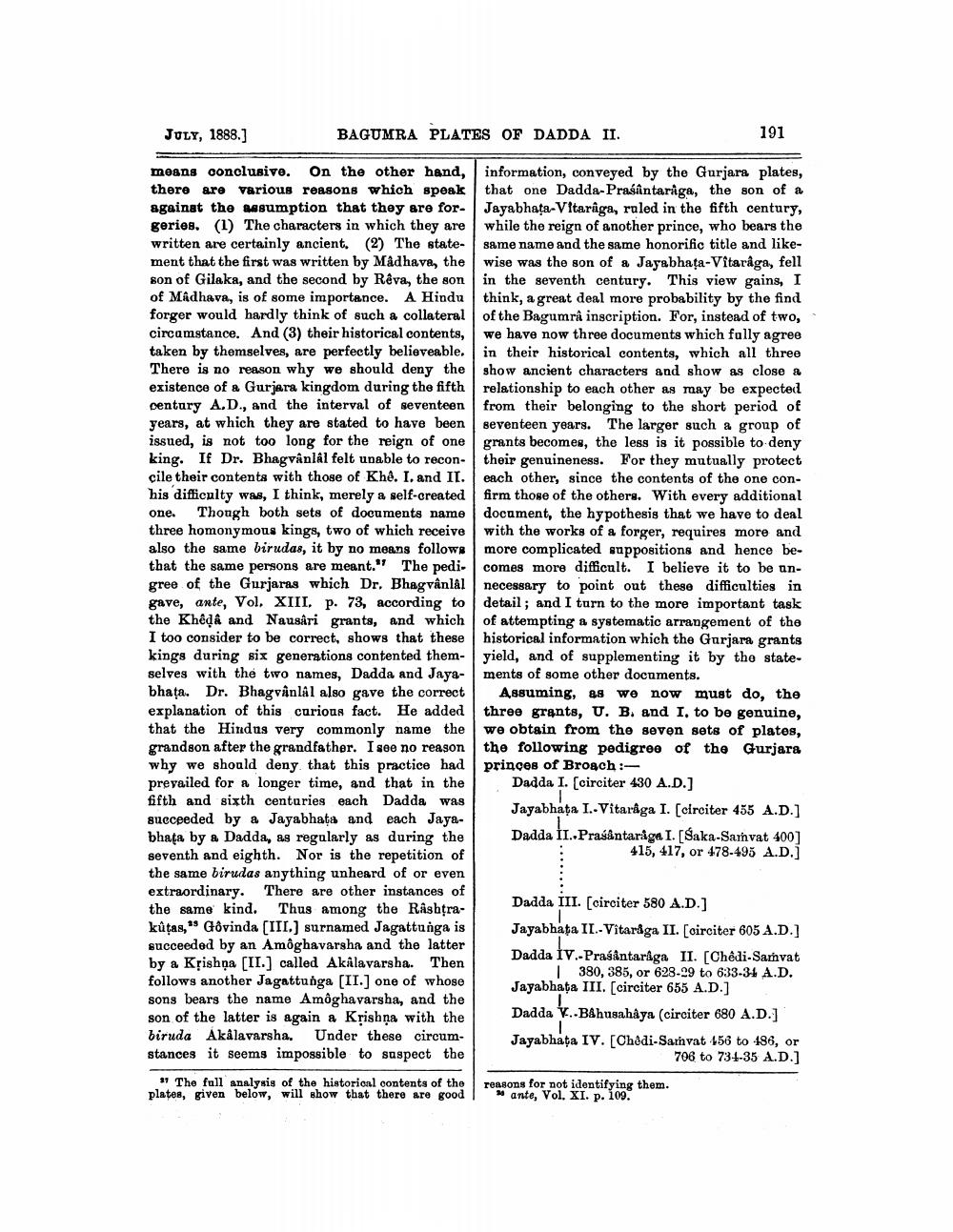________________
JULY, 1888.)
BAGUMRA PLATES OF DADDA II.
191
means conclusive. On the other hand, information, conveyed by the Gurjara plates, there are various reasons which speak that one Dadda-Prasantaraga, the son of a against the sumption that they are for- Jayabhata-Vitaraga, ruled in the fifth century, gerios. (1) The characters in which they are while the reign of another prince, who bears the written are certainly ancient. (2) The state- same name and the same honorific title and likement that the first was written by Madhava, the wise was the son of a Jayabhaça-Vitaraga, fell son of Gilaka, and the second by Rêva, the son in the seventh century. This view gains, I of Madhava, is of some importance. A Hindu think, a great deal more probability by the find forger would hardly think of such a collateral of the Bagumrâ inscription. For, instead of two, circumstance. And (3) their historical contents, we have now three documents which fally agree taken by themselves, are perfectly believeable. in their historical contents, which all three There is no reason why we should deny the show ancient characters and show as close a existence of a Gurjara kingdom during the fifth relationship to each other as may be expecteil century A.D., and the interval of seventeen from their belonging to the short period of years, at which they are stated to have been seventeen years. The larger such a group of issued, is not too long for the reign of one grants becomes, the less is it possible to deny king. If Dr. Bhagvanlal felt unable to recon- their genuineness. For they mutually protect cile their contents with those of Khê. I. and II. each other, since the contents of the one conhis difficulty was, I think, merely a self-created firm those of the others. With every additional one. Though both sets of documents name document, the hypothesis that we have to deal three homonymous kings, two of which receive with the works of a forger, requires more and also the same birudas, it by no means follows more complicated suppositions and hence bethat the same persons are meant." The pedi. comes more difficult. I believe it to be angree of the Gurjaras which Dr. Bhagvânlal necessary to point out these difficnlties in gave, ante, Vol. XIII. p. 73, according to detail; and I turn to the more important task the Khôdk and Nausâri grants, and which of attempting a systematic arrangement of the I too consider to be correct, shows that these historical information which the Gurjara grants kings during six generations contented them- yield, and of supplementing it by tho stateselves with the two names, Dadda and Jaya- ments of some other documents. bhata. Dr. Bhagvanlal also gave the correct Assuming, as we now must do, the explanation of this curious fact. He added three grants, U. B. and I, to be genuine, that the Hindus very commonly name the we obtain from the seven sets of plates, grandson after the grandfather. I see no reason the following pedigree of the Gurjara why we should deny that this practice had princes of Brosch:prevailed for a longer time, and that in the Dadda I. (circiter 430 A.D.) fifth and sixth centuries each Dadda was
Jayabhata I. Vitarâga I. (circiter 455 A.D.] succeeded by a Jayabhata and each Jayabhata by a Dadda, as regularly as during the
Dadda II. Prasantaråga I. (Saka-Sarnvat 400] seventh and eighth. Nor is the repetition of
415, 417, or 478-495 A.D.] the same birudas anything unheard of or even extraordinary. There are other instances of the same kind. Thus among the Rashtra
Dadda III. (circiter 580 A.D.] kůtas, as Gôvinda (III.) surnamed Jagattunga is Jayabhata IL-Vitaråga II. [circiter 605 A.D.] succeeded by an Amôghavarsha and the latter
Dadda Iv.-Prasantaraga II. (Chêdi-Sarvat by a Krishịa (II.) called Akalavarsha. Then
380, 385, or 628-29 to 633-34 A.D. follows another Jagattunga (II.) one of whose
Jayabhata III. (circiter 655 A.D.] song bears the name Amôghavarsha, and the son of the latter is again a Krishna with the
Dadda K.-BÅhusahaya (circiter 680 A.D.] biruda Akâlavarsha. Under these circum
Jayabhata IV. (Chodi-Samvat 456 to 486, or stances it seems impossible to suspect the
706 to 731-35 A.D.]
"The full analysis of the historioal contents of the plates, given below, will show that there are good
Tonsons for not identifying them.
ante, Vol. XI. p. 109.




